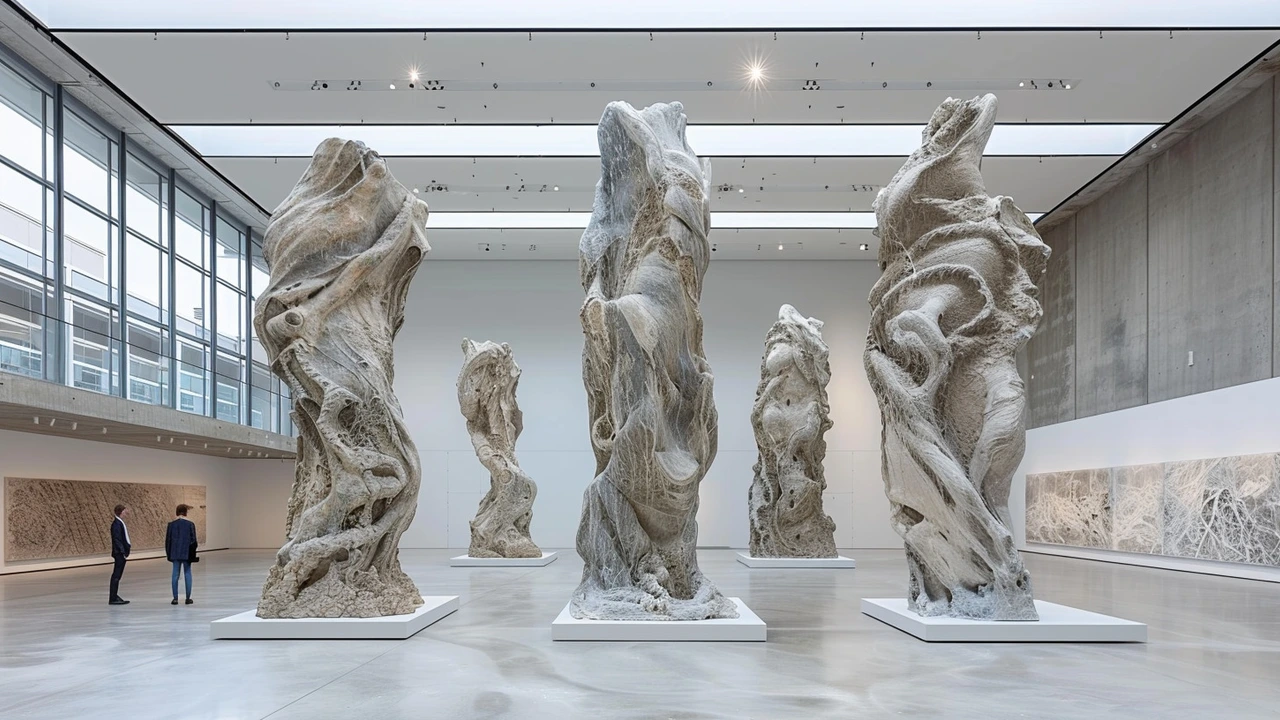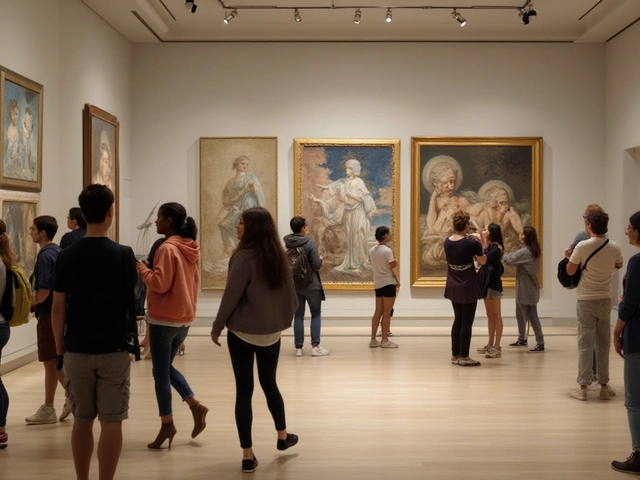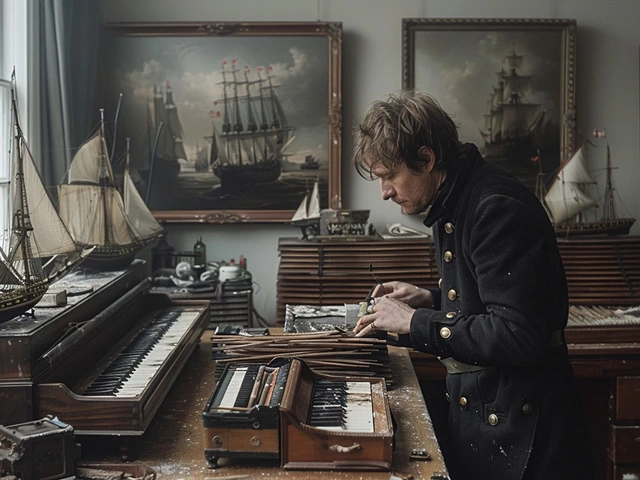Conceptual art shook the foundation of the art world in the mid-20th century. It wasn't about the final appearance of the artwork, but more about the ideas and concepts behind it. This shift marked a significant departure from traditional art forms, urging viewers and artists alike to think deeply about meaning and intention.
The early pioneers of conceptual art were often considered radical, pushing against the conventional boundaries and norms. They created works that focused on thought processes and provoked intellectual discourse. This article delves into their groundbreaking contributions and their lasting impact on contemporary art.
- Defining Conceptual Art
- The Early Visionaries
- Mid-Century Innovators
- The Impact on Contemporary Art
- Interesting Facts About Pioneers
- Tips for Aspiring Conceptual Artists
Defining Conceptual Art
Conceptual art emerged in the 1960s as a reaction against the status quo in the art world. It emphasized the artist's ideas and intentions over traditional aesthetic and material concerns. This genre revolutionized modern art by focusing on the meaning behind works, often challenging viewers to question and interpret what they see.
Unlike traditional art forms that stress the final produced piece, conceptual art is more about the underlying concept. This notion was articulated perfectly by Sol LeWitt, a pioneering artist, who stated, "In conceptual art the idea or concept is the most important aspect of the work." By shifting the focus to ideas, conceptual art opened the door to innovative approaches that allowed artists to transcend physical and technical constraints.
One of the critical aspects of conceptual art is its diversity in form. Artists employ various mediums, including text, performance, and installations, to convey their messages. This flexibility allows for an expansive range of expression, making it a versatile and dynamic artistic form. For instance, the works of Joseph Kosuth, another influential figure, often used everyday language and objects to explore and question the nature of art and its role in society.
Influence from Philosophical Thought
Many of the ideas in conceptual art are rooted in philosophical theories, particularly those of Ludwig Wittgenstein and Marcel Duchamp. Wittgenstein's language theory significantly influenced conceptualists, encouraging them to explore the relationships between words, objects, and meaning. Duchamp, considered an early progenitor with his readymades, pushed the boundaries by presenting everyday objects as art, thereby urging viewers to rethink their preconceptions.
This philosophy-driven approach brought a new dimension to art. It wasn't only about visual impact but also about engaging the intellect. The complexity and richness of these ideas made conceptual art a fertile ground for experimentation and dialogue. Conceptualists aimed to disrupt traditional narratives and provoke thought, often creating a profound and lasting impact on their audience.
Conceptual artists often employed text as a central component of their pieces. This element added a layer of meaning and allowed for more direct communication of ideas. The use of text in art can be traced back to Lawrence Weiner, who used simple declarative statements to engage viewers, encouraging them to interpret the work in their own way. This minimalistic approach emphasized the importance of personal interpretation, making the art experience more interactive and thought-provoking.
Key Characteristics of Conceptual Art
Conceptual art is identified by several defining characteristics. Firstly, it privileges ideas over aesthetic value. Artists often forsake traditional beauty for the sake of conveying a deeper meaning or questioning societal norms. Secondly, it relies heavily on the viewer's interpretation, making the audience an integral part of the artwork's realization. This interplay between artist, artwork, and audience creates a dynamic and engaging experience.
Furthermore, conceptual art often challenges the commodification of art. By emphasizing ideas over physical objects, artists critique the commercialization of their work. This resistance to the market dynamics of art highlights a commitment to intellectual and philosophical exploration over monetary gain. Finally, conceptual art frequently engages with contemporary social and political issues, offering commentary and insights that encourage reflection and debate. Given its thought-provoking and often challenging nature, it continues to resonate, influencing numerous contemporary artists and practices.
The Early Visionaries
In tracing the origins of conceptual art, one cannot overlook the fundamental role played by early 20th-century artists who bravely challenged the norms of their time. Names like Marcel Duchamp instantly come to mind. Duchamp's provocative piece, 'Fountain,' which is essentially a porcelain urinal, transcended conventional notions of art. By signing it 'R. Mutt,' he questioned authorship and originality, thrusting the idea behind the piece into the spotlight.
Duchamp once famously remarked, 'I forced myself to contradict myself in order to avoid conforming to my own taste.' This desire to break free from artistic norms inspired a generation of artists to pursue art that explored ideas rather than aesthetics. His work set a precedent for conceptual thinking, proving that art doesn’t need to be visually pretty to make a profound statement.
The early days of conceptual art were also heavily influenced by the Dada movement. Founded in Zurich in 1916, Dadaists like Hugo Ball and Tristan Tzara embraced absurdity and anti-art sentiments, rejecting the established standards. Their radical performances and nonsensical text were wild protests against the horrors of World War I and the traditional values that had led to it. This merging of art and life, a key concept in Dada, would become a cornerstone of conceptual art.
Another towering figure in the early conceptual art scene was Joseph Kosuth. In the mid-1960s, Kosuth began creating art that emphasized linguistic and theoretical inquiry. His work 'One and Three Chairs' (1965), featuring a chair, a photograph of that chair, and an enlarged dictionary definition of the word 'chair', examined the relationships between language, representation, and meaning. This type of intellectual rigor would become central to conceptual art, leading to rich discussions around how meaning is constructed.
Yoko Ono, often celebrated more for her association with John Lennon, was also a significant figure in the early days of conceptual art. Her 'Grapefruit' (1964), a book of instructions on how to imagine or perform various artistic acts, broke down the barriers between audience and artist. Ono’s work invited people to engage with art on a deeply personal level, highlighting the participatory nature of conceptual art.
By the time the 1950s and 60s rolled around, the foundations laid by these pioneers began to flourish into a fully-fledged movement. Artists like Sol LeWitt, famous for his 'Paragraphs on Conceptual Art' (1967), emphasized that the 'idea or concept is the most important aspect of the work,' further echoing the sentiments of his predecessors. LeWitt’s focus on ideas rather than the execution profoundly influenced how art would be perceived and created thereafter.
While these artists came from diverse backgrounds and philosophies, their unifying factor was a shared belief in the power of ideas. Their ground-breaking works and daring initiatives questioned what art could be, paving the way for future generations to explore art in ways previously unimaginable. The legacy of these early visionaries continues to inspire and resonate in the art world today.

Mid-Century Innovators
The 1960s and 1970s were a period of radical change and experimentation in the art world. During this time, conceptual art took its place at the forefront of the avant-garde, driven by a group of pioneering artists who were unafraid to challenge the status quo. One of the most iconic figures of this era was Joseph Kosuth, whose work 'One and Three Chairs' created in 1965, epitomizes the essence of conceptual art. His art did not merely present an object but asked viewers to ponder the representation and idea behind it.
Another prominent name from this period is Sol LeWitt. His 'Sentences on Conceptual Art,' a manifesto written in 1969, solidified many of the principles that contemporary conceptual artists would follow. LeWitt's wall drawings, which were merely verbal instructions, were revolutionary. By allowing other people to create the physical artwork from his instructions, he emphasized the supremacy of the concept over the final visual product.
"The idea becomes the machine that makes the art." – Sol LeWittThis quote by LeWitt encapsulates the spirit of conceptual art, where the 'idea' is the core of the artistic process.
Yoko Ono, another icon, broke conventional boundaries with her participative and performance-based art. Her work, 'Cut Piece' (1964), where she invited the audience to cut away pieces of her clothing, involved the viewers in the artistic process and questioned traditional roles of artist and audience. Another essential figure was John Baldessari. Known for his wit and irreverence, Baldessari’s work often critiqued the art world itself, blending photography, painting, and text into thought-provoking pieces.
Lawrence Weiner also deserves mention. A central figure in the conceptual art movement, Weiner is known for his text-based works. His statement 'Declaration of Intent' (1968) spelled out his philosophy of art: '1. The artist may construct the piece. 2. The piece may be fabricated. 3. The piece need not be built.' Weiner’s text pieces, often installed directly onto walls, remove the emphasis on physical materials, directing the viewer’s attention to the idea itself.
Another unmissable figure from this period is Bruce Nauman. Known for his diverse and often challenging body of work, Nauman explored various mediums, from sculpture to video installations. His piece 'The True Artist Helps the World by Revealing Mystic Truths' (1967) is a neon sign that encapsulates the ironic and self-reflective nature of his art.
The mid-century period was undoubtedly transformative, with these innovators pushing art into new, uncharted territories. They encouraged future artists to prioritize intellectual engagement over aesthetic pleasure, laying a foundation that still supports many of today’s contemporary practices.
The Impact on Contemporary Art
The advent of conceptual art during the mid-20th century marked a transformative period in the art world. Traditional values of aesthetics, form, and technique were overtaken by new priorities that centered on ideas and the meaning behind the artwork. This movement effectively broadened the scope of what could be considered art, underscoring the notion that the creative process and the artist's intention could hold as much, if not more, significance than the final product itself.
Conceptual artists like Sol LeWitt, often hailed as one of the pillars of this movement, famously stated, "The idea becomes a machine that makes the art." This quote encapsulates a fundamental ethos in conceptual art – the belief that the generation and communication of ideas define the essence of art. By championing this philosophy, conceptual artists paved the way for contemporary art practices that frequently merge multiple disciplines such as performance, science, and technology. This interdisciplinary approach has expanded the boundaries of what art can accomplish and how it can be experienced.
Moreover, conceptual art has directly influenced key aspects of today’s contemporary art scene. For instance, the rise of installation art and the use of immersive, interactive experiences can be traced back to the pioneering works of conceptual artists. Yoko Ono's

Interesting Facts About Pioneers
Conceptual art wouldn't be where it is today without the trailblazing efforts of early pioneers. These artists broke the mold and redefined what art could be. One of the most captivating examples is Sol LeWitt, who believed that the idea or concept behind a work was more important than the final product. His wall drawings were instructions for others to execute, reflecting his belief in art as a collaborative, democratized process. This focus on the underlying idea changed how people viewed and interacted with art.
Another intriguing figure is Marcel Duchamp, often considered the grandfather of conceptual art. He shocked the world with his famous piece, 'Fountain'—a urinal signed 'R. Mutt.' This work questioned the boundaries of what could be considered art. Duchamp's work has inspired countless contemporary artists who embrace unconventional materials and concepts.
"It's not what you see that is art; art is the gap." – Marcel Duchamp
An equally groundbreaking influence was Yoko Ono. Her 'Instruction Paintings' invited the audience to participate in the creative process. She offered simple, poetic instructions that transformed the viewers into creators. This participatory approach was groundbreaking, opening up new avenues for audience interaction and engagement in the realm of art.
Joseph Kosuth's 'One and Three Chairs' is a textbook example of how conceptual artists use everyday objects to convey philosophical ideas. By placing a chair, a photograph of a chair, and a dictionary definition of a chair side by side, Kosuth encouraged viewers to ponder the very nature of representation. His work has left a lasting imprint on how art can challenge perceptions and provoke thought.
One of the lesser-known but equally fascinating pioneers is On Kawara, who chronicled the passage of time through his 'Today Series.' Each painting featured the date on which it was created, reflecting on the fleeting nature of human existence. His minimalist approach and daily commitment to this series offer a unique commentary on time and memory.
Finally, Jenny Holzer's truisms brought conceptual art into the public sphere. Using electronic displays and billboards, she presented thought-provoking phrases intended to spark dialogue on issues ranging from politics to personal relationships. Her work has made conceptual art more accessible and relevant to the general public.
These pioneers paved the way for future generations of artists. Their stories and works continue to inspire, challenging the boundaries and expectations of what art can be. Whether through Duchamp's provocations, Ono's participatory art, or Holzer's public interventions, these conceptual artists have left an indelible mark on the art world.
Tips for Aspiring Conceptual Artists
Becoming a conceptual artist involves more than just mastering traditional techniques and tools. It requires a deep understanding of the concepts and ideas that can provoke thought and inspire change. One of the most crucial aspects is to always stay curious. Keep asking questions about the world around you. Why are things the way they are? How can they be different? Never stop exploring new ideas and finding ways to express them artistically.
Another vital tip is to experiment with different mediums and materials. Do not restrict yourself to canvases and paint. Conceptual art can involve anything from performance to digital media, installation art, and even everyday objects. Look at how Marcel Duchamp used a simple urinal and transformed it into ‘Fountain,’ a piece that challenged the very essence of what art could be.
“Art is an idea. It is not something that can be defined by a specific medium or process,” says Sol LeWitt, a renowned pioneer of conceptual art.
If you are serious about a career in conceptual art, it is essential to stay informed about the movements and trends both in contemporary and historical contexts. Visit galleries, read art magazines, and network with other artists. Do not shy away from collaborations as they can lead to exciting new perspectives and insights. The art world thrives on connections and interactions. Forming a network can provide opportunities that you might not have access to on your own.
Focus on developing your unique voice. This isn't just about standing out; it’s about creating work that genuinely resonates with your personal views and experiences. To find your unique style, you need to reflect on what matters most to you and how you can convey that through art. Don't be afraid to explore sensitive or controversial topics, as art is a powerful medium for social commentary. Barbara Kruger’s work, for example, uses bold text and images to confront issues related to power, identity, and feminism.
Another valuable approach is to keep a journal or sketchbook where you can jot down ideas, draw concepts, and map out potential projects. This can become a rich source of inspiration and a way to track the evolution of your thoughts over time. Even seemingly insignificant notes can lead to profound ideas for future projects.
Embrace Failure
One of the core lessons in conceptual art is that failure is just a stepping stone. Don’t be afraid to make mistakes. Each failed attempt brings you one step closer to a breakthrough. Consider it a part of the creative process. Tracey Emin’s ‘My Bed’ might have seemed like a risky and unconventional idea, but it ended up garnering critical acclaim and making a significant impact.
Finally, never stop learning. Art, in all its forms, is constantly evolving. Take courses, attend workshops, and read extensively. Knowledge is your most powerful tool. By staying educated, you keep your mind open to new techniques, perspectives, and ideas that can enrich your work.



